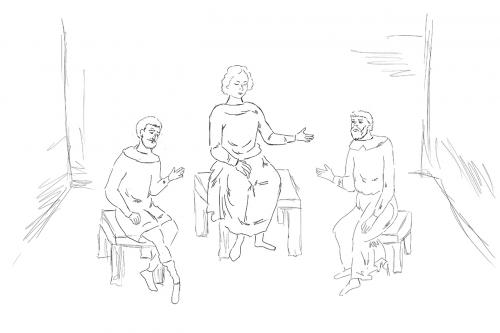



Joseph Interpreting the Dreams of the Cupbearer and the Baker
The story of Patriarch Joseph’s youth has often been a source in Christian literature, allegorically foretelling Jesus’ life. Themes such as “The Selling of Joseph into Slavery”, “Joseph and Potiphar’s Wife”, or “Potiphar’s Wife Falsely Accusing Joseph” were seen as parallels to “Judah’s Treason”, “The Temptation of Christ” and “Jesus’ Process”. Although these are Old Testament references frequently employed, the scenes from Joseph’s life have been less evoked in Byzantine and Post-Byzantine art, compared to the notoriety they enjoyed in Western art since Early Christianity. That is why there are no explicit canons for such iconographical representations.
The scene “Joseph Interpreting the Dreams of the Cupbearer and the Baker” is not frequently represented in Byzantine and Post-Byzantine art, thus there is no definite canon to depict it.
Usually, the scene is placed against an architectural background meant to sketch the interior of a prison. In the centre of the image there are the three characters: Joseph, the cupbearer and the baker. To emphasize Joseph’s status as main character, he is shown standing in front of the seated two other or sitting between them. The gestures of the three characters suggest a vivid conversation. Details of dressing and hints regarding the content of the dreams, or the future fate of the dreamers are later developments or Western influences.
The story of Patriarch Joseph’s youth has often been a source in Christian literature, allegorically foretelling Jesus’ life. Themes such as “The Selling of Joseph into Slavery”, “Joseph and Potiphar’s Wife”, or “Potiphar’s Wife Falsely Accusing Joseph” were seen as parallels to “Judah’s Treason”, “The Temptation of Christ” and “Jesus’ Process”. Although these are Old Testament references frequently employed, the scenes from Joseph’s life have been less evoked in Byzantine and Post-Byzantine art, compared to the notoriety they enjoyed in Western art since Early Christianity. That is why there are no explicit canons for such iconographical representations.
The scene “Joseph Interpreting the Dreams of the Cupbearer and the Baker” is not frequently represented in Byzantine and Post-Byzantine art, thus there is no definite canon to depict it.
Usually, the scene is placed against an architectural background meant to sketch the interior of a prison. In the centre of the image there are the three characters: Joseph, the cupbearer and the baker. To emphasize Joseph’s status as main character, he is shown standing in front of the seated two other or sitting between them. The gestures of the three characters suggest a vivid conversation. Details of dressing and hints regarding the content of the dreams, or the future fate of the dreamers are later developments or Western influences.




